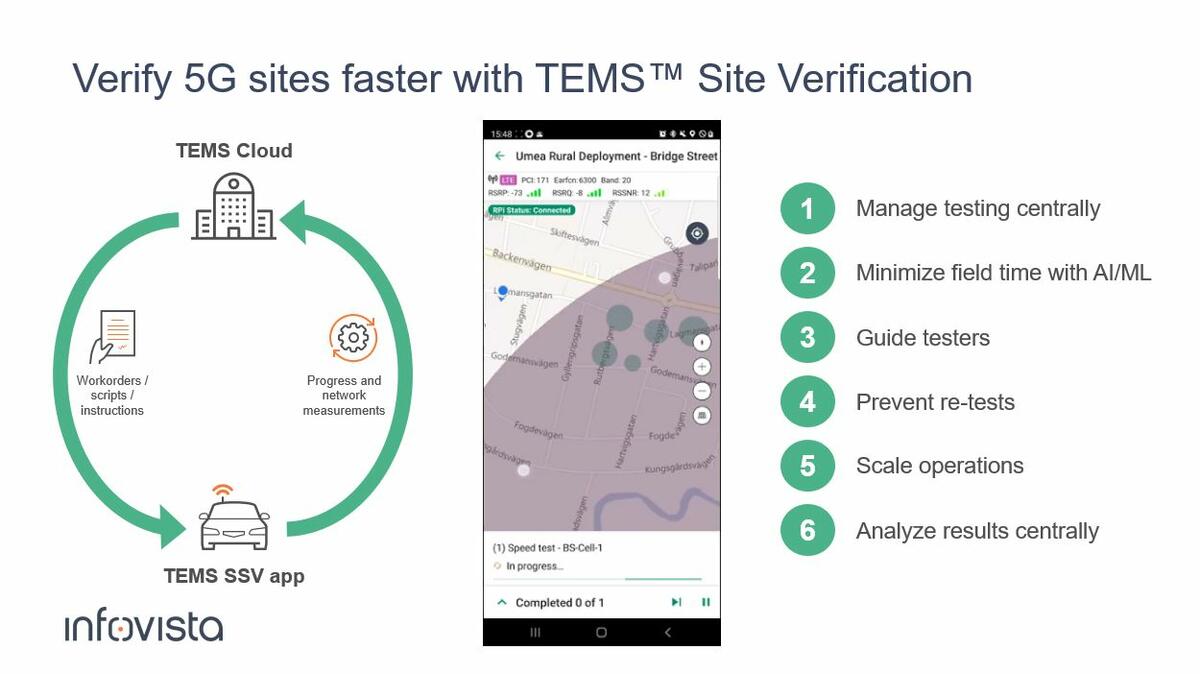Whether it’s rolling out a new 5G network, a new technology overlay, or expanding your network coverage footprint, accurately assessing prelaunch performance is critical. Only by testing and optimizing the network from your subscribers’ perspective can you be confident that the network is going to deliver the promised 5G user experience. In this blog series, we’ll look at 12 different use cases for next-generation network testing which mobile operators and system integrators are using today to optimize the roll-out of new 5G networks. From drone-based testing to strategic location monitoring, they all have an important role to play. However, it all starts with 5G site verification.
What is 5G site verification?
Site verification involves validating that new 5G sites and clusters provide the intended coverage and that all voice and data services are working as expected before subscribers are allowed to access the network.
What are the main challenges of 5G site verification?
Within a mobile operator’s organization, the responsibility for site verification sits with the network deployment team. The challenge is one of complexity and scale. For every new site that is built, the network deployment team needs to ensure it is well integrated with its neighbors in the existing network and performing optimally.
In the case of most 5G network roll-outs, this will involve many thousands of sites each requiring comprehensive drive testing. This potentially means your team collectively driving hundreds of thousands miles (for a nationwide US operator it can total over 1 million miles of drive testing!). This is time-consuming, it’s expensive, and it’s the sort of thing that can blow a small hole in your organization’s efforts to de-carbonize your 5G investments. Finding efficiencies is critical.
Efficient and accurate 5G site verification requires automated and centralized management. Only by centrally defining testing routines and criteria, and identifying what to test, where to test and how to get there, can you streamline the drive testing process and accelerate the acceptance of your new 5G sites.
What are the benefits of automated 5G site verification?
Operators are experiencing huge traffic levels and high rates of traffic growth. This means that, in many places, 5G needs to be brought into service urgently. But running on a higher frequency, 5G requires a denser network, with up to 20 times as many base stations as 4G. This means that more sites will need to be rolled out in a shorter time. In turn, this demands rapid site verification, which can only be properly addressed through automation.
Automation speeds up data management, data analysis, and task and workflow management, as well as decision automation. With automation, operators can become more proactive and more predictive, and find operational efficiencies that will improve the bottom line.
Next-generation automated site verification will:
- Improve site verification efficiency with centralized orchestration of testing projects and detailed guidance for drive testers
- Improve the time taken for a site verification by automating testing routines and leveraging machine learning to predict where tests should be done
- Reduce reliance on your skilled engineers with guidance and automation that enables anyone to do site verification
- Evaluate site verification in real-time so that issues can be detected early and corrected, preventing time-consuming re-drives
How to carry out 5G site verification efficiently
For 5G site verification, mobile operators rely on Infovista’s TEMS™ suite, specifically TEMS SSV App combined with TEMS Cloud.
The skills required for validating new sites are often a significant bottleneck in 5G roll-outs. The TEMS SSV App leverages Precision Drive Testing™ to provide a simple user interface with on-screen guidance and automated execution of testing routines, meaning even people with no RF expertise can test for you and report results back to HQ for analysis.

Using TEMS Cloud, RF experts define and distribute the required testing routines to TEMS SSV. With this approach, your site verification process is significantly more scalable, helping you get your 5G network to market faster.
As part of the site acceptance process, the following tests are performed:
- Stationary tests to confirm that the cell handles traffic
- Intra-site mobility tests (clockwise and anticlockwise) to check handovers between sectors
- Inter-site mobility tests (in and out) to check handovers with neighboring cells
In conclusion
The traditional approach to site acceptance normally requires highly skilled staff to spend hours on a site laboriously collecting data, and then off-site producing a report to document acceptance.
5G introduces additional challenges that make it even more time-consuming, and easier to miss key conditions. Performing the optimal number of tests for each feature at each place is very difficult to agree on.
Powered by TEMS Precision Drive Testing, our Automated Site Verification solution offers a flexible and feature-rich experience for automated site acceptance. It ensures consistent processes are followed throughout every site verification project, reducing operational complexity, improving time to market with significant cost saving.
Get in touch with our technology experts to discuss how the Automated Site Verification solution can benefit your site acceptance process.
More helpful pages:
- eBook: Evolving network testing – 12 TEMS™ use cases
- Solution brief: Automated Site Verification
- Case study: How a major European MNO uses the TEMS™ Suite to deliver its 5G network
- Analyst Report: The evolution from drive testing to multi-level automated testing in 5G (Senza Fili)










